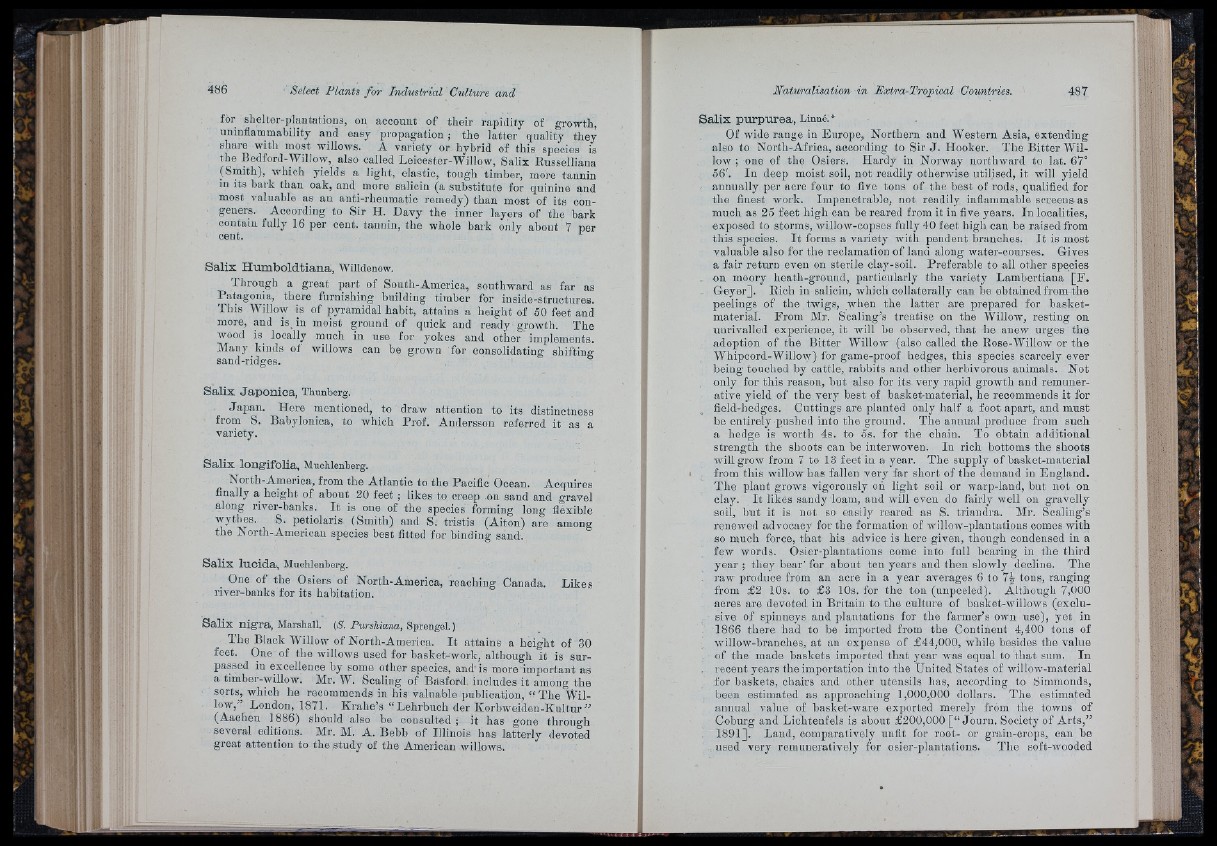
for sbelter-plautations, on account of their rapidity of growth,
uninflaminability aud easy propagation ; the latter quality they
share with most willows. A variety or hybrid of this species is
tbe Bedford-WilJow, also called Leicester-Willow, Salix Eusselliana
(Smith), which yields a light, elastic, tough timber, more tannin
iu its bark than oak, and more salicin (a substitute for quinine and
most valuable as an anti-rheumatic remedy) than most of its congeners.
According to Sir H. Davy the inner layers of the bark
contain fully 16 per cent, tannin, the whole bark only about 7 per
cent.
Salix Humboldtiana, Willdenow.
Through a great part of South-America, southward as far as
Patagonia, there furnishing building timber for inside-structnres.
This Willow is of pyramidal habit, attains a height of 50 feet and
more, and is_ in moist ground of quick and ready growth. The
wood is locally much in use for yokes and other implements.
Many kinds of willows can be grown for consolidating shifting
saud-ridges.
Salix Japónica, Thunberg.
Japan. Here mentioned, to draw attention to its distinctness
from S. Babylonica, to which Prof. Andersson referred it as a
variety.
Salix longifolia, Muehlenberg.
North-America, from the Atlantic to the Pacific Ocean. Acquires
finally a height of about 20 feet ; likes to creep on sand and gravel
along river-banks. I t is one of the species forming long flexible
wytlies. S. petiolaris (Smith) and S. tristis (Aiton) are among
the North-American species host fitted for binding sand.
Salix luoida, Muehlenberg.
^ One of the Osiers of North-America, reaching Canada,
river-banks for its habitation.
Likes
SaEx nigra, Marshall. (8. Pwshiana, Sprengel.)
The Black Willow of North-America. I t attains a height of 30
feet. One of tlie willows used for basket-work, although it is surpassed
in excellence by some other species, and'is more important as
a timber-willow. Mr. W. Scaling of Basford includes it among the
sorts, which he recommends in his valnable publication, “ The Willow,’
London, 1871. Krahe’s “ Lehrbuch der Korbweiden-Kultur ”
(Aachen 1886) should also be consulted; it has gone through
several editions. Mr. M. A. Bebb of Illinois has latterly devoted
great attention to the study of the American willows.
Salix purpurea, Linné.*
Of wide range in Europe, Northern and Western Asia, extending
also to North-Africa, according to Sir J . Hooker. The Bitter Willow
; one of the Osiers. Hardy iu Norway northward to lat. 67°
56'. In deep moist soil, not readily otherwise utilised, it will yield
annually per acre four to five tons of the best of rods, qualified for
the finest work. Impenetrable, not readily inflammable screens as
much as 25 feet high can be reared from it in five years. In localities,
exposed to storms, willow-copses fully 40 feet high can be raised from
this species. I t forms a variety with pendent branches. I t is most
valuable also for the reclamation of land along water-courses. Gives
a fair return even on sterile clay-soil. Preferable to all other species
, on moory heath-ground, partioularly the variety Lambertiana [F .
Geyer]. Eich in salicin, which collaterally can be obtained from the
peelings of the twigs, when the latter are prepared for basket-
material. From Mr. Sealing’s treatise on the Willow, resting on
unrivalled experience, it will be observed, that he anew urges the
adoption of the Bitter Willow (also called the Rose-Willow or the
Whipcord-Willow) for game-proof hedges, this species scarcely ever
being touched by cattle, rabbits and other herbivorous animals. Not
only for this reason, but also for its very rapid growth and remunerative
yield of the very best of basket-material, he recommends it for
field-liedges. Cuttings are planted only half a foot apart, and must
be entirely pushed into the ground. The annnal produce from such
a hedge is worth 4s. to 5s. for the chain. To obtain additional
strength the shoots can be interwoven. Iu rich bottoms the shoots
will grow from 7 to 13 feet in a year. The supply of basket-material
from this willow has fallen very far short of the demand in England.
The plant grows vigorously oii light soil or warp-land, but not on
clay. I t likes sandy loam, and will even do fairly well on gravelly
soil, hut it is not so easily reared as S. triandra. Mr. Scaling’s
renewed advocacy for the formation of willow-plantatious comes with
so much force, that his advice is here given, though condensed in a
few words. Osier-plantations come into full bearing in the third
year ; they hear' for about ten years and then slowly decline. The
raw produce from an acre iu a year averages 6 to 74 tons, ranging
from £2 10s. to £3 10s. for the ton (nnpeeled). Although 7,000
acres are devoted in Britain to the cnlture of basket-willows (exclusive
of spinneys and plantations for the farmer’s own use), yet in
1866 there had to be imported from the Continent 4,400 tons of
willow-branches, a t an expense of £44,000, while besides the value
- of the made baskets imported th a t year was equal to th a t sum. In
. recent years the importation into the United States of willow-material
for baskets, chairs and other utensils has, according to Simmonds,
been estimated as approaching 1,000,000 dollars. The estimated
annual value of basket-ware exported merely from the towns of
Coburg and Liohtenfels is about £200,000 [ “ Journ. Society of Arts,”
1891]. Land, comparatively unfit for root- or grain-crops, can be
used very remuneratively for osier-plantations. The soft-wooded